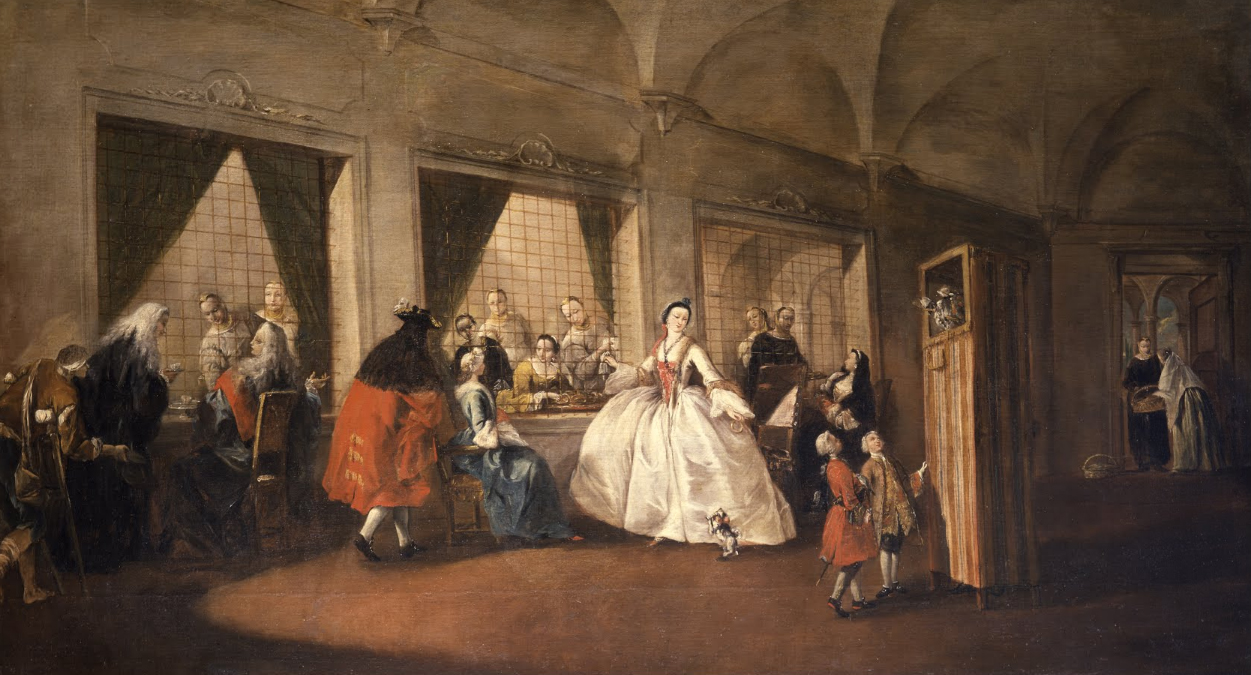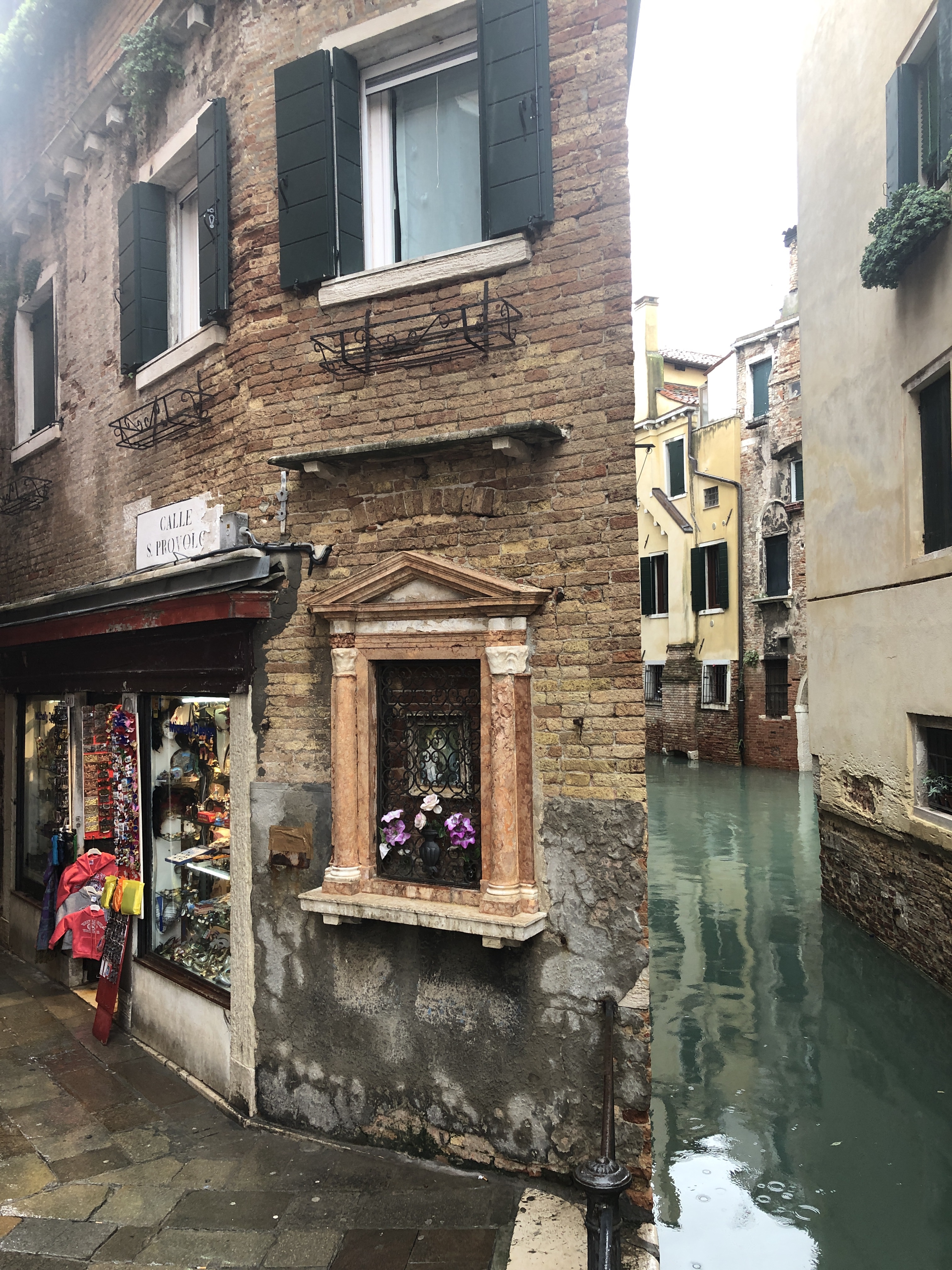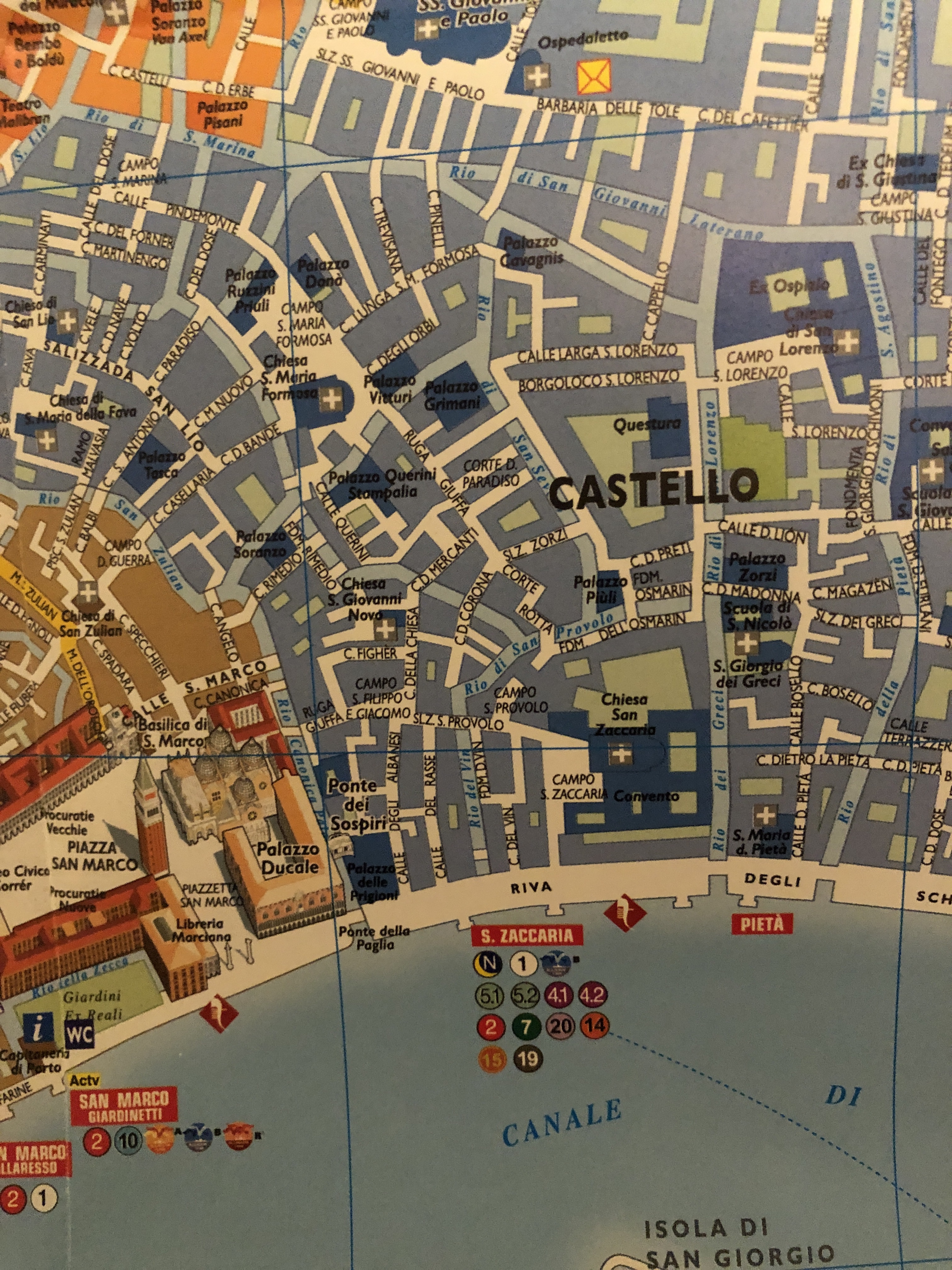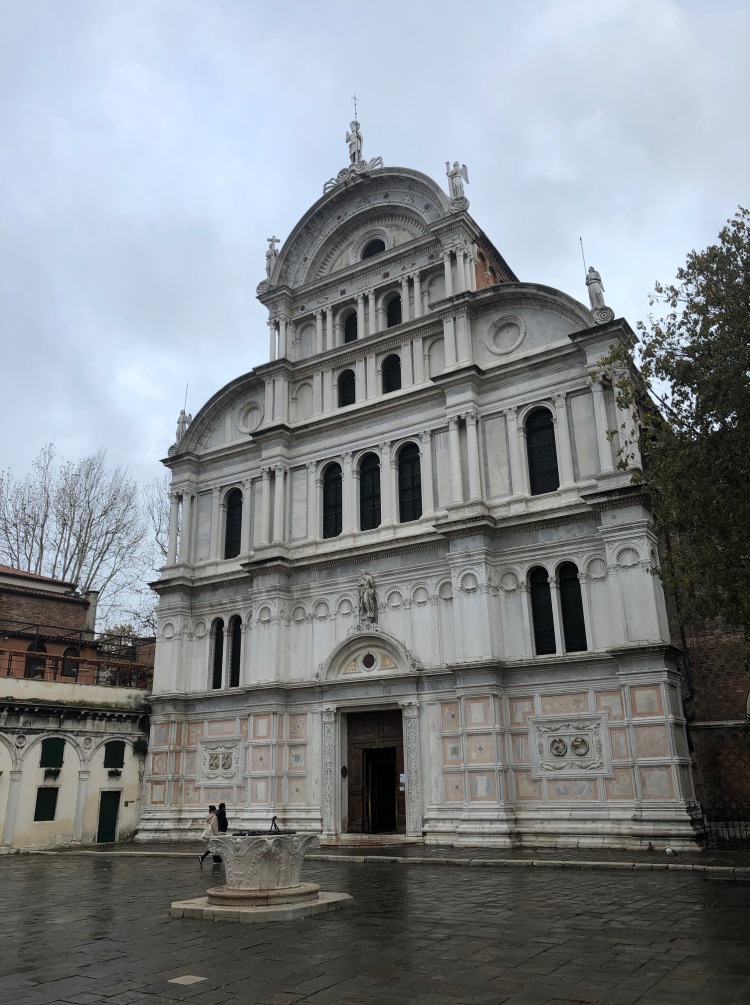The Venetians were always a curious mixture of piety, god-fearing behaviour and ruthless independence. Typical seafarers, they built their city, quite literally, from the mud and sand banks of the lagoon. From mud flat to mud flat they consolidated the foundations of Venice with thousands of logs, shipped into the city from the mountains to the north. These logs were hammered into the alluvium of the lagoon, one at a time, like fence posts, thousands of them, until strong foundations had been established. Then houses, churches and public buildings were constructed, first of wood and later of brick and stone. Five hundred years later a city of elaborate palaces, churches and basilicas was the envy of the Mediterranean. A city of great wealth and beauty.
VENICE TODAY – In Venice a square is known as a ‘campo‘. Almost every ‘campo’ in Venice has a church, a palazzo and a well. After all you needed water to survive and a church to guide and control your spiritual well-being. There’s estimated to be about 140 churches in Venice today. Each church and each ‘campo’ has a unique and distinctive character. That means you could visit two or three churches a week, and it would take you a year to get round them all. You’d never have to go to the same church twice. So if you fell out with the local priest there would be another shepherd waiting to welcome you to the flock just a few streets away.
FROM THE SEA – As you approach Venice from the sea, the bell tower of St Mark’s looms majestically above the skyline. To the east is the Doge’s Palace, seat of government for the Republic of Venice for 1000 years. This waterfront is one of the busiest in the city. Public boats, tourist boats, gondolas all dock here. The pavement is a mixture of white Istrian stone and grey granite flags. The fondamente is lined with hotels; Daniele, Savoia & Jolanda, Londra Palace. It is called Riva degli Schiavoni, a reference to the Slavic merchants who loaded and unloaded their cargoes here, plying their trade between Venice and the Dalmatian Coast for centuries. This waterfront has always been crowded, it’s an arrival point and a departure point. Observant visitors may notice a bell tower, leaning at a jaunty angle, a short distance inland, it is the Campanile of San Giorgio dei Greci, the only Greek Orthodox Church in Venice, built by the Greek community of merchants as their special place of worship. Today this area is still Venice’s Little Greece!

In Venice every building, every stone, every wooden mooring post, has a story to tell. The polished stones under your feet have a story to tell. When Ruskin wrote ‘The Stones of Venice’ in the 19th century, his title was a perfect choice. For the stones of Venice are not just building blocks that create houses, churches and palaces, they are also witnesses to the past. To a unique city with an exceptional, cosmopolitan and international history. Just one hundred paces from Riva degli Schiavoni heading north-west is the ‘Campo San Zaccaria’. The square is dominated by the elegant, classical facade of the eponymous church. Originally built in the 9th century to house the body of Zaccaria, father of John the Baptist, it was later rebuilt in a mixture of styles described as a combination of Gothic and early Renaissance. The front of the church is symmetrical and almost Dutch in the style of the stepped gables. It is imposing and impressive. Next door the original church and monastery are still visible.
Everyone in Venice knows the name San Zaccaria, it is one of the busiest boat stops in town; Ferrovia, Piazzale Roma, San Marco, San Zaccaria. It’s on the tip of every vaporetto operator’s tongue. But I wonder how many Venetians know that this was the church built to house the remains of John the Baptist’s father about 1200 years ago. Certainly the myriad of tourists less than a minute’s walk away on Riva Schiavoni have got no idea. It’s definitely time to go into the church and discover some unexpected treasure inside. In my experience there’s almost always an incredible painting or sculpture that leaves me open-mouthed and amazed. Now what could it be, I wonder, in this church?
BELLINI – In San Zaccaria it’s a Giovanni Bellini altarpiece, located on the north side of the church, painted in 1505. Yes, that’s right painted in 1505 – it is more than 500 years old. The colours, rendition and perspective are incredible. The painting is of the Madonna and child surrounded by the saints; Peter, Jerome, Catherine of Alexandria and Lucy. The church is incredibly gloomy and dark, I manage to avoid the incredibly helpful caretaker and locate the box, where, if you drop in a 50 cent coin you get light on the Bellini masterpiece for 5 minutes. As the light illuminates Bellini’s work the richness of the colours, the facial expressions of the main characters and the exceptional detail are quite fascinating. Experts say that Bellini, in this painting had been influenced by Giorgione. Giorgione was a Venetian painter from Castelfranco, brought up in the beautiful Venetian countryside, just about where the plains of the Veneto mingle with the foothills of the Alps. There is a hint of Venetian landscape behind St Jerome on the right hand side of the painting. I can make out the keys of St Peter on the left hand side and the broken wheel of St Catherine, also on the left. Saint Lucy is on the right of the painting carrying a small bowl, usually this is a lamp, bringing light, as Lucy’s name (Luce – light in italian) suggests. I always enjoy symbolism in a painting, especially when I can actually see and understand it, otherwise I dislike it intensely!

Bellini Masterpiece – San Zaccaria, Venezia – 1505 / photo: www.educated-traveller.com

Outside back in the ‘campo‘ I marvel at the richness of Venice’s historic heritage, art, and architecture, there’s always something new to discover in Venice. Round every corner there’s a hidden Bellini, Tintoretto or Titian masterpiece. Immediately outside the church there’s a very pretty shop, it’s a herbalist selling all manner of lotions and potions, soaps and candles – in the old days these would have been made by the nuns in the monastery next door to the church. Today the herbalist does brisk trade with a steady stream of tourists from the east, which is amusing and ironic as Venice has always acquired vital revenue and income from the orient. The monastic convent of San Zaccaria was a notoriously relaxed order, many of the nuns were from aristocratic families, and were related to various doges. The nuns were famously painted by Francesco Guardi in their ‘Parlatorio’. A ‘parlatorio‘ literally means ‘chatting room’ and presumably is the derivation of our English word ‘parlour’, a room where you receive guests and chat, from the Italian ‘parlare’ to talk. In Guardi’s painting of the ‘Parlatorio‘ or chatting room, the nuns can be seen seated behind the screen at the back of the room. I can’t help thinking the ladies made their escape at carnival time, masked and fully gowned to join in the festivities. Let’s face it, in life things are rarely exactly as they seem.


The ‘campo’ of San Zaccaria is delightful and authentic, even though it’s only a handful of steps from the waterfront it is peaceful and quiet. There’s a selection of shops too, including a traditional embroidery shop selling linen handkerchiefs, tablecloths and cute traditional outfits for babies. The type of impractical one-piece sailor suits that grandmothers always buy for their grandchildren. I’m feeling hungry now and I walk under the ‘sottoportego‘ or archway which separates Campo San Zaccaria from the neighbouring campo of San Provolo. I’m in search of a snack, I just need to get my hands on a couple of ‘cicchetti’ which are Venetian style snacks. Miraculously, thank you Mr Almighty there’s a ‘bacaro‘ or bar on the corner of the square. It is a tiny, tiny bar, with a counter and maybe six stools in an L-shape around the outside wall. The barman is friendly and the freshly made ‘cicchetti’ are delicious – I have at least four. I also sample a glass of organic, unfiltered prosecco – it is quite delicious. A little ‘macchiato‘ coffee and I’m all set.

VENICE is all about seeing and noticing, observing the details in every building, listening to people and absorbing the atmosphere. After my snack I stroll another few years and I spot a joinery shop. It is filled with all types of timber and I can see the shape of the ‘forcola’ which is the Venetian piece of carved wood that supports the gondolier’s pole when he steers and manoeuvres his craft. This workshop is making these ‘forcole‘ by hand, carefully carved, using the same techniques that are handed down from generation to generation. Even today Venice is a city of artisans, and it is the existence of these artisans that make the city unique and vibrant.



The richness of art, architecture and history within the city of Venice is probably greater per square metre than anywhere else in Europe. Venice is already a UNESCO World Heritage Site. A city that represents the very best of human endeavour. It is our duty to respect and honour this exceptional city. A city that defies the odds and exists in a suspended almost ethereal state, marooned between land and sea. So next time you visit Venice I urge you to wander and discover, escape the crowds and meander. You really don’t have to go far from the madding crowds to really discover the rich tapestry of this maritime city.

To discover more about Venice why not investigate some of these links:
- Botticelli – Venice – Botticelli in Venice – seriously?
- Little Greece – A little piece of Greece in Venice
- Venice and Acqua Alta – Acqua Alta – Venice
- There’s a wonderful blog about Venice by Iris Loredana – La Venessiana
- For an insider’s guide to Venice it is completely charming.
- A little more history: If you’d like to know more about the saints in Bellini’s painting, I can fill you in on: St Catherine’s sad story: St Catherine of Alexandria
- Also Lucy – Lucia: The legend of St Lucy – that’s Santa Lucia in Italy
- I haven’t written Peter and Jerome yet.
- Although I have written about Angels and Saints: Saints and Angels in Venice…
- Enjoy and have fun exploring!
- One last thing – Campo San Zaccaria is a favourite photo location at the time of Venice’s Carnival (Carnevale) this superbly outfitted Native American Indian woman, complete with dream catcher feathers, poses on the well head just outside the church (below). For more on Carnevale – follow this link to an article I wrote a year or two ago: Venice – Carnival 2020

- Written: 21-11-2019
- Updated: 20th January, 2021
- And again July, 2024





Thank you Iris – looking forward to supporting you in 2023 xxx
LikeLiked by 1 person
Beautifully written article Janet. I will bring going back to see Bellinis painting. It’s a lovely area to visit.
LikeLiked by 1 person
Many thanks Katharine – if you type Venice into the http://www.educated-traveller.com blog page you’ll find numerous quirky articles on Venice and Veneto. Enjoy!
LikeLiked by 1 person
thank you so much for this wonderful visit in san zacharia. I went there (and many times since) first when I was 19 with my father who was a lover of Venice and an incredible guide of your city. I took there my husband and children many times and go to San zacchria to see bellini Madonna and pray for all of us everytime …
LikeLiked by 1 person
Thank you Nathalie – what a lovely message – I too love Bellini’s Madonna with Saints. xxxxx
LikeLiked by 1 person
Thank you Nathalie – I’m glad you enjoyed it. You might also enjoy my recent article about angels and saints in Venice. Happy Reading!
LikeLike
And I just re-read this–you have such a wonderful knack for “seeing” and then reporting to us in exquisite detail. I especially enjoyed reading about the Bellini masterpiece–much more meaningful the second time around. Thank you, Janet!
LikeLiked by 1 person
Thank you so much Mary Lou – that painting has really developed a very special meaning for me – each of the saints (all clustered around Mary and Jesus) each supporting the Son of God in a different way!
LikeLike
Just when I think your writing can’t get any better, it does! This is a wonderful tour of oneof Venice’s churches and its artwork that is so meaningful. Thank you, Janet!
LikeLiked by 1 person
Con piacere (with pleasure) xxxx
LikeLike